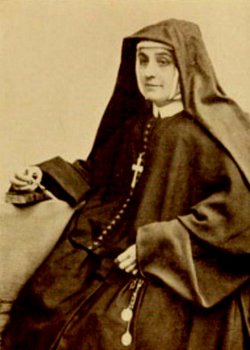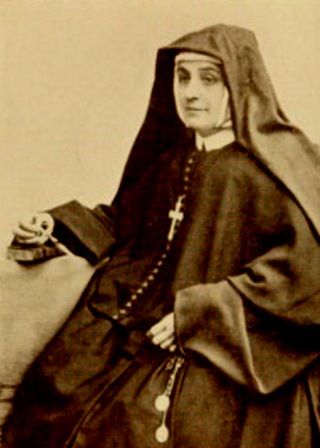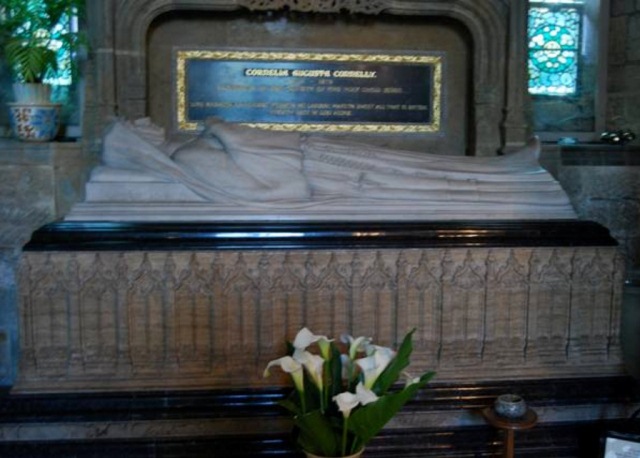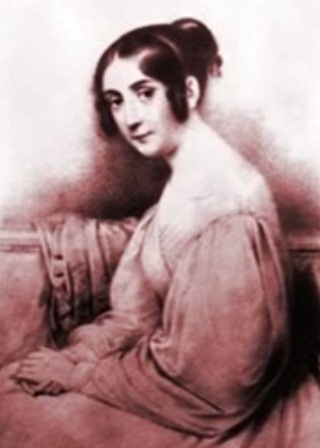Cornelia Peacock was born in Philadelphia on January 15, 1809, the youngest child of a large family. We know that her father died when she was nine. By the age of fourteen she had lost both parents and was living with her sister.
She was an attractive, well-educated woman with a lively personality who was described as being intelligent, happy, strong-minded, hot-tempered and untidy. The Philadelphia of Cornelia's youth was a vibrant city: the Declaration of Independence had been signed there just over thirty years before. Cornelia absorbed the spirit of her native city and, all her life, was independent, creative and courageous.
In December 1831, despite family opposition, Cornelia married Pierce Connelly, an Episcopalian priest, with whom she had fallen deeply in love. There were mixed reactions among her relatives but Cornelia and Pierce from all accounts had a very happy relationship.
After their marriage Pierce and Cornelia set up home in Natchez, Mississippi, where Pierce had accepted the rectorship of Trinity Episcopal church. They lived for three years at White Cottage where their first two children, Mercer and Adeline, were born. In August 1835 Pierce resigned his pastorate in order to explore the claims of the Roman Catholic Church.
Both Pierce and Cornelia religion held a place of importance. They were young believers who searched for answers to the most serious questions of their lives.
In the spring of 1838, on their return from Europe, the Connellys accepted an invitation to live and work at Grand Coteau. In this remote Louisiana outpost, Pierce taught English at the Jesuit college and Cornelia taught music at the Sacred Heart School while raising their children, Mercer, Adeline, John Henry, Mary Magdalene, and tutoring. Their faith was supported by spiritual direction, retreats, and conversation with the priests and nuns. Their spiritual lives and personal relationships endured a series of painfilled events. Here, in July 1839, their second daughter, Mary Magdalene, was born but died after only two months.
In early 1840, still grieving the death of her baby daughter, Cornelia made her first retreat of three days. God touched her deeply and her interior life was profoundly changed. She gave herself in a new way to God, desiring to do God's will as it was made known to her through her duties and the events of daily life.
Within five months her beloved John Henry, two years old, was scalded in a tragic accident and died in Cornelia's arms. Cornelia and Pierce buried John Henry in a double grave with Mary Magdelene at Grand Coteau, Louisiana. From this anguish was born in her a life-long devotion to Mary as Mother of Sorrows.
On October 13, 1840, Pierce told her that he was certain that God was calling him to pursue the priesthood and the Church. Cornelia was four months pregnant with their fifth child, Frank, and urged her husband to consider his proposal carefully but added characteristically that if God asked it of her, she would make the sacrifice — and with all her heart.
Mary Magdalene lived only about six weeks and is buried with John Henry in a
Before Pierce could become a priest, Cornelia was obliged to take a vow of chastity and she was encouraged to enter a religious order. In April 1844 Cornelia entered the Sacred Heart Convent at the Trinita dei Monti under special conditions, taking her baby son, Frank, with her. Cornelia was not happy, but she lived here for two years and in July 1845 Pierce was ordained in the convent chapel. Cornelia was driven by the Spirit to a deep trust of God's working in her life. At the same time, Pierce was enjoying his priestly ministry in Rome.
While living at the Trinita, Cornelia began making tentative preparations for a congregation of which she would be the foundress. In 1846, encouraged by Lord Shrewsbury and Bishop Wiseman, she established the first house of the Society of the Holy Child Jesus in England. There she began to manifest her qualities as a leader in education and spirituality
In 1846, the new Foundress with her two youngest children, Adeline and Frank, and three companions arrived in Derby. In this growing industrial town in the English midlands, Bishop Wiseman provided this new community with a large and quite unsuitable house.
The Society of the Holy Child Jesus had begun. Its beginning was small and there were many deprivations, but a spirit of joy and peace prevailed; Cornelia was able to inspire in her sisters something of her own serenity in adversity. They embarked upon a ministry of education among mill girls and poor children, setting up day and night schools as well as Sunday classes to accommodate the young factory workers, giving retreats and helping in the parishes.
Within two years, however, Pierce was creating difficulties for Cornelia. He was disillusioned and uncertain both about his own vocation to the priesthood and by hers to religious life. She was shaping her philosophy of education based on her life experience: the education of students would be best accomplished in a setting of trust and caring attention for each student.
Most of Cornelia's life as foundress of the Society of the Holy Child Jesus was spent at St. Leonards-on-Sea in Sussex. Here she established schools on her own principles and philosophy. Here too she endured her greatest personal sufferings—Pierce's abandonment of the Roman Catholic priesthood and estrangement from her children. Pierce renounced both his priesthood and his Catholic faith, removed their three children from the schools they were attending and denied Cornelia all contact with them, hoping thus to force her to return to him as his wife. He even pressed a lawsuit against her that gained notoriety in England, but he eventually lost the case.
Not surprisingly, Pierce soon resumed his position in the Episcopal Church. For over thirty years, he wrote anti-Catholic tirades, many attacking his Cornelia. He also turned the children against her. It all took a toll on Cornelia, who rarely discussed the experience. In her diary, she wrote: "I must not dwell on deep sorrow, for I am without the power of remedy." Although some Catholics saw in her a scandal, she often used the scripture quote: "It must be that scandals come." Through the years, Cornelia fought priests and bishops seeking closer control of her community, and she won. One Sister observed that she "looks as if she must be obeyed." Still, another added, her major trait was a "bright encouraging spirit."
Mercer, their eldest son, died of yellow fever in the USA at the age of 20, completely estranged from his mother. Adeline visited Cornelia only once in adult life. She never married, but lived with her father until his death in Florence in 1883 (four years after Cornelia). After Pierce died, Adeline returned to the practice of Catholicism. Frank never married either, though he cared for and educated his illegitimate daughter, Maria Cornelia, who subsequently married into the Italian aristocracy. Through her, Cornelia continues to have direct descendants. Frank, who shared his father's hatred of Catholicism, met his mother on only two occasions after early childhood, and, tradition has it, he accused her of loving the nuns more than she loved him. He became an artist and sculptor, dying in 1932.
In this suffering, Cornelia clung steadfastly to God, her strength. She wrote in her notebook, "I belong all to God," and this total belonging freed her to give herself to others. Her love for God grew and she sought joyfully to live her life as one continuous act of love. She endured suffering and learned not to be embittered by it. Joy became one of her hallmarks and a hallmark of Holy Child education. Cornelia died at St. Leonards on April 18, 1879 and was buried at Mayfield. Later her body was transferred to this tomb in the fourteenth century chapel. Amadeus Atchison, the superior general at the time, choose as her epitaph:
Love knoweth no measure
Feareth no labour
Findeth rest in God alone.
By the time of her death in 1879, the Holy Child Sisters had expanded throughout England, onto the continent, and across the United States. Today its headquarters are in Rome, and its founder is on the track to sainthood. Cornelia was declared Venerable on June 13, 1992 by Pope John Paul II.
In the 19th-century world, a woman was essentially her husband's property. Although many saw in convent life a loss of liberty, it was only there that Cornelia Connelly discovered true freedom. For half her life, others made decisions for her. It was only when she embraced a religion alleged to be oppressive and misogynistic that she took charge and discovered her true self. But it came at a cost that no wife and mother should ever have to pay.
Cornelia Peacock was born in Philadelphia on January 15, 1809, the youngest child of a large family. We know that her father died when she was nine. By the age of fourteen she had lost both parents and was living with her sister.
She was an attractive, well-educated woman with a lively personality who was described as being intelligent, happy, strong-minded, hot-tempered and untidy. The Philadelphia of Cornelia's youth was a vibrant city: the Declaration of Independence had been signed there just over thirty years before. Cornelia absorbed the spirit of her native city and, all her life, was independent, creative and courageous.
In December 1831, despite family opposition, Cornelia married Pierce Connelly, an Episcopalian priest, with whom she had fallen deeply in love. There were mixed reactions among her relatives but Cornelia and Pierce from all accounts had a very happy relationship.
After their marriage Pierce and Cornelia set up home in Natchez, Mississippi, where Pierce had accepted the rectorship of Trinity Episcopal church. They lived for three years at White Cottage where their first two children, Mercer and Adeline, were born. In August 1835 Pierce resigned his pastorate in order to explore the claims of the Roman Catholic Church.
Both Pierce and Cornelia religion held a place of importance. They were young believers who searched for answers to the most serious questions of their lives.
In the spring of 1838, on their return from Europe, the Connellys accepted an invitation to live and work at Grand Coteau. In this remote Louisiana outpost, Pierce taught English at the Jesuit college and Cornelia taught music at the Sacred Heart School while raising their children, Mercer, Adeline, John Henry, Mary Magdalene, and tutoring. Their faith was supported by spiritual direction, retreats, and conversation with the priests and nuns. Their spiritual lives and personal relationships endured a series of painfilled events. Here, in July 1839, their second daughter, Mary Magdalene, was born but died after only two months.
In early 1840, still grieving the death of her baby daughter, Cornelia made her first retreat of three days. God touched her deeply and her interior life was profoundly changed. She gave herself in a new way to God, desiring to do God's will as it was made known to her through her duties and the events of daily life.
Within five months her beloved John Henry, two years old, was scalded in a tragic accident and died in Cornelia's arms. Cornelia and Pierce buried John Henry in a double grave with Mary Magdelene at Grand Coteau, Louisiana. From this anguish was born in her a life-long devotion to Mary as Mother of Sorrows.
On October 13, 1840, Pierce told her that he was certain that God was calling him to pursue the priesthood and the Church. Cornelia was four months pregnant with their fifth child, Frank, and urged her husband to consider his proposal carefully but added characteristically that if God asked it of her, she would make the sacrifice — and with all her heart.
Mary Magdalene lived only about six weeks and is buried with John Henry in a
Before Pierce could become a priest, Cornelia was obliged to take a vow of chastity and she was encouraged to enter a religious order. In April 1844 Cornelia entered the Sacred Heart Convent at the Trinita dei Monti under special conditions, taking her baby son, Frank, with her. Cornelia was not happy, but she lived here for two years and in July 1845 Pierce was ordained in the convent chapel. Cornelia was driven by the Spirit to a deep trust of God's working in her life. At the same time, Pierce was enjoying his priestly ministry in Rome.
While living at the Trinita, Cornelia began making tentative preparations for a congregation of which she would be the foundress. In 1846, encouraged by Lord Shrewsbury and Bishop Wiseman, she established the first house of the Society of the Holy Child Jesus in England. There she began to manifest her qualities as a leader in education and spirituality
In 1846, the new Foundress with her two youngest children, Adeline and Frank, and three companions arrived in Derby. In this growing industrial town in the English midlands, Bishop Wiseman provided this new community with a large and quite unsuitable house.
The Society of the Holy Child Jesus had begun. Its beginning was small and there were many deprivations, but a spirit of joy and peace prevailed; Cornelia was able to inspire in her sisters something of her own serenity in adversity. They embarked upon a ministry of education among mill girls and poor children, setting up day and night schools as well as Sunday classes to accommodate the young factory workers, giving retreats and helping in the parishes.
Within two years, however, Pierce was creating difficulties for Cornelia. He was disillusioned and uncertain both about his own vocation to the priesthood and by hers to religious life. She was shaping her philosophy of education based on her life experience: the education of students would be best accomplished in a setting of trust and caring attention for each student.
Most of Cornelia's life as foundress of the Society of the Holy Child Jesus was spent at St. Leonards-on-Sea in Sussex. Here she established schools on her own principles and philosophy. Here too she endured her greatest personal sufferings—Pierce's abandonment of the Roman Catholic priesthood and estrangement from her children. Pierce renounced both his priesthood and his Catholic faith, removed their three children from the schools they were attending and denied Cornelia all contact with them, hoping thus to force her to return to him as his wife. He even pressed a lawsuit against her that gained notoriety in England, but he eventually lost the case.
Not surprisingly, Pierce soon resumed his position in the Episcopal Church. For over thirty years, he wrote anti-Catholic tirades, many attacking his Cornelia. He also turned the children against her. It all took a toll on Cornelia, who rarely discussed the experience. In her diary, she wrote: "I must not dwell on deep sorrow, for I am without the power of remedy." Although some Catholics saw in her a scandal, she often used the scripture quote: "It must be that scandals come." Through the years, Cornelia fought priests and bishops seeking closer control of her community, and she won. One Sister observed that she "looks as if she must be obeyed." Still, another added, her major trait was a "bright encouraging spirit."
Mercer, their eldest son, died of yellow fever in the USA at the age of 20, completely estranged from his mother. Adeline visited Cornelia only once in adult life. She never married, but lived with her father until his death in Florence in 1883 (four years after Cornelia). After Pierce died, Adeline returned to the practice of Catholicism. Frank never married either, though he cared for and educated his illegitimate daughter, Maria Cornelia, who subsequently married into the Italian aristocracy. Through her, Cornelia continues to have direct descendants. Frank, who shared his father's hatred of Catholicism, met his mother on only two occasions after early childhood, and, tradition has it, he accused her of loving the nuns more than she loved him. He became an artist and sculptor, dying in 1932.
In this suffering, Cornelia clung steadfastly to God, her strength. She wrote in her notebook, "I belong all to God," and this total belonging freed her to give herself to others. Her love for God grew and she sought joyfully to live her life as one continuous act of love. She endured suffering and learned not to be embittered by it. Joy became one of her hallmarks and a hallmark of Holy Child education. Cornelia died at St. Leonards on April 18, 1879 and was buried at Mayfield. Later her body was transferred to this tomb in the fourteenth century chapel. Amadeus Atchison, the superior general at the time, choose as her epitaph:
Love knoweth no measure
Feareth no labour
Findeth rest in God alone.
By the time of her death in 1879, the Holy Child Sisters had expanded throughout England, onto the continent, and across the United States. Today its headquarters are in Rome, and its founder is on the track to sainthood. Cornelia was declared Venerable on June 13, 1992 by Pope John Paul II.
In the 19th-century world, a woman was essentially her husband's property. Although many saw in convent life a loss of liberty, it was only there that Cornelia Connelly discovered true freedom. For half her life, others made decisions for her. It was only when she embraced a religion alleged to be oppressive and misogynistic that she took charge and discovered her true self. But it came at a cost that no wife and mother should ever have to pay.
Family Members
Advertisement
Explore more
Sponsored by Ancestry
Advertisement











